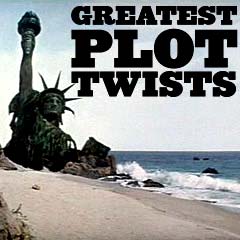
|
Film Spoilers and Surprise Endings F2 |
|
|
||||||||||||||
| Film Title/Year and Plot Twist-Spoiler-Surprise Ending Description | ||||||||||||||

|
The Fifth Element (1997, Fr.) (aka Le Cinquième Élément)
Writer/director Luc Besson's science-fiction techno-thriller epic, set in a futuristic 23rd century NYC (2263 AD), was noted for its exceptional sets, visual effects and costume designs, and its basic plot-line of good vs. evil. Its tagline was:
The film opened in an Egyptian temple in 1914, where an Italian hieroglyphics expert Professor Pacoli (John Bluthal) was deciphering a drawing:
The film posited the idea that a Great Evil (a huge ball of molten lava and fire) arrived approximately every 5,000 years, threatening to destroy all of humanity. The only weapon to defeat the Great Evil consisted of:
The "Fifth Element" had the ability to combine the power of the other four elements into a "Divine Light" that could stop the Great Evil ("Together, they produce the "Light of Creation" that can bring life to the farthest reaches of the Universe").
At the moment of great discovery by the Professor, a Mondoshawan spaceship landed with giant alien creatures who announced: "War is coming. Stones not safe on Earth anymore." They opened a chamber holding an upright sarcophagus with the "Fifth Element." They gathered up the four stones (of the four elements) and put them in a case, and took the sarcophagus. Their goal was to defend themselves against the Great Evil that would come upon them in 300 years. 300 Years Later (in the year 2263 AD), a giant ball of black fire was threatening to destroy Earth, fulfilling the prediction. As the Mondoshawan spacecraft was bringing the Fifth Element back to Earth to protect it, it was destroyed by warships from the evil Mangalores, a race of aliens directed by evil industrialist Jean-Baptiste Emanuel Zorg (Gary Oldman), who was working on behalf of the Great Evil. The only surviving portion of the "Fifth Element " from the destroyed Mondoshawan spacecraft was a severed hand - it was used in a memorable regeneration or body reconstruction scene in a NY nucleolab by a team of scientists, to resurrect a Perfect Being - a beautiful nude woman with orange hair - an extra-terrestrial female named Leeloo (Milla Jovovich). Leeloo was teamed up with cab-driver and former soldier Major Korben Dallas (Bruce Willis) after literally diving off a multi-story Manhattan building into his vehicle. She was the humanoid embodiment of love, a Perfect Being who was the only one who could stop the impending arrival of the Great Evil from ultimately destroying Earth. In a race against time, Dallas and Leeloo joined forces to combat the evil, apocalyptic forces of Zorg and his mercenaries, whose enlisted goal was to trigger the disaster. Leeloo's and Dallas' main mission was to recover the four stone elements, and together with Leeloo ("the Fifth Element") defeat the Great Evil before it struck Earth. The film's final scene was inside the Egyptian temple where the stones had been activated, but Leeloo was unsure that Earth was worth saving. Dallas confessed his love for Leeloo and kissed her (showing her their love was worth saving), to convince her to release the power of the stones and cause the Divine Light to destroy the approaching molten mass of Great Evil in the Earth's atmosphere (only 62 miles from impact) ("Scanner imaging has confirmed the dark planet dead. The planet seems to have stopped at 62 miles from impact").
When the Federation President Lindberg (Tom Lister, Jr.) arrived to congratulate Dallas and Leeloo for saving Earth, he had to wait for them to finish making love in a healing tank. |
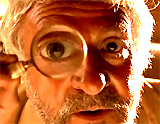 Professor Inspecting a Drawing in Ancient Egyptian Temple in Early 20th Century (1914)  "The Fifth Element" To Save Earth 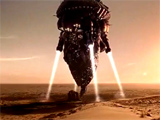 Mondoshawan Spaceship Landing  Professor and Mondoshawan Alien  Great Ball of Fire  Evil Mangalore Alien Creature - Aknot  Severed Hand of the 5th Element  Coming to Life  Leeloo (Milla Jovovich)  Major Korben Dallas (Bruce Willis)  Jean-Baptiste Emanuel Zorg (Gary Oldman) |
||||||||||||

|
Fight Club (1999)
Director David Fincher's adaptation of Chuck Palahniuk's 1996 novel, of male insecurities and violence, had the tagline:
The twisting drama was told in flashback, with an opening voice-over during a confounding scene in which the film's two main characters were confronting each other. The "Narrator" was being held at gunpoint (the gun was in his mouth!) by Tyler Durden, during a count-down to "ground zero" -- the demolition of twelve corporate buildings (credit card companies) by a movement known as "Project Mayhem." Tyler Durden threatened the destruction unless the "Narrator" shot himself:
An unnamed "Narrator" (Edward Norton), a bored, self-help addicted, and disillusioned corporate worker, found excitement (and a cure for his insomnia) in the twilight, underground world of a macho "Fight Club" that featured bare-knuckle boxing. He enjoyed pretending to be a victim. There in the "Fight Club" support group, the "Narrator" was involved with:
His life was soon turned upside down. By the film's ending, it was revealed that Tyler Durden was actually one side of the split personality-psyche of the "Narrator's" own imagination. This was a classic plot twist device - of an "unreliable narrator." During a conversation with himself (and with Tyler), "Jack"/the Narrator realizes that he is one and the same with Durden:
'Tyler' explained the split personality phenomenon:
During the explosive finale as terrorist violence escalated through activities called "Project Mayhem," Tyler threatened to blow up a dozen buildings of various major credit card companies and couldn't be subdued by the "Narrator." The only way the "Narrator" could destroy, stop or kill "Durden" in his mind was by shooting himself in the jaw/face. He fired a gun through his head - to stop the mental projections of Tyler Durden. The "Narrator" barely survived his own bloody and painful 'enlightenment' as he witnessed the destruction of various skyscrapers with girlfriend Marla Singer (Helena Bonham Carter) at his side. He told her:
|
 The Opening Voice-Over (and Ending) 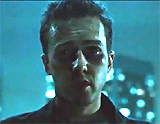 "The Narrator" (Edward Norton) 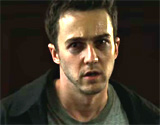  "Jack"/The Narrator = "Tyler Durden"   "Narrator" Shooting Himself in Conclusion 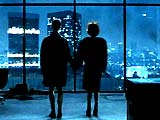 "Narrator" With Marla Watching Destruction |
||||||||||||

|
Final Destination 5 (2011)
Director Steven Quale's fifth installment of the long-running horror film series since the year 2000, had the taglines:
It resumed the premise of all the films in the franchise -- that if one evaded a violent public death through a premonition, the Grim Reaper would eventually kill the survivors of the major disaster, or in the words of the ever-present coroner William Bludworth (Tony Todd):
It opened with a group of Presage Paper Company factory co-workers and associates on a bus traveling to a "team-building" corporate retreat, and about to cross the North Bay Bridge. One office worker named Sam Lawton (Nicholas D'Agosto) had a premonition that the poorly-constructed suspension bridge was about to collapse, and his friends and associates, including himself (and the bus driver), were about to be mangled or drowned in his dream:
However, Sam's premonition led him to safely rescue everyone. Then, most of the group would again suffer agonizing, gory Rube Goldberg-styled deaths, starting with the demise of Candice, Isaac, and Olivia (the deaths of survivors numbered):
A new twist (or "wrinkle") was introduced by coroner Bludworth after their deaths -- he suggested that to cheat death, one must kill someone and thereby claim their remaining lifespan:
Soon, the eight survivors of the bridge accident began dying in the order they were meant to die on the bridge. And there were two murders or killings as well:
Sam and Molly both assumed that they were now safe, since Peter killed Block and Sam killed Peter (and thus acquired Block's life), and Molly never died on the bridge in the first place. A few weeks later, the remaining survivors were passengers on Flight 180 to Paris (in Final Destination (2000)), who were killed when the plane exploded:
Simultaneously in the final scene, Nathan Sears was at a small makeshift wake/memorial for Roy in a cocktail bar. Nathan was speaking to factory co-worker John (Roman Podhora), who noted that an autopsy had revealed that their friend Roy was about to die even before his accidental death: "Company did an autopsy for insurance purposes. Turns out Roy had an enlarged blood vessel in his brain so big, it was about to burst. They said he'd be dead any day now." Nathan responded: "Any day?" John's reply was the final line of the film: "Life's a bitch." A few seconds later, Nathan (8) - not saved by Roy's death, was crushed by the falling plane's fiery landing gear crashing through the bar's ceiling. |
 Bus Trip to Company Retreat - Beginning of Disaster 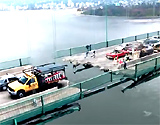 Bridge Collapse Premonition - Death's Averted 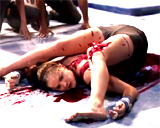 Candice's Death 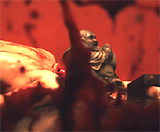 Isaac's Death  Olivia's Death  Coroner: William Bludworth (Tony Todd) "You shorted Death..."  Nathan: "Any day?"  John: "Life's a bitch."  Nathan's Death |
||||||||||||

|
(John Carpenter's) The Fog (1980)
Writer/director John Carpenter's next film, following his breakout hit Halloween (1978), was this studio-backed, low-budget horror film about a deadly fog in a Northern California coastal town. [Note: An inferior remake of the film, a teen horror film with an unusual plot twist, was released 25 years later, The Fog (2005) directed by Rupert Wainwright.] Its tagline provided the summary:
The under-rated film opened with three ominous foreshadowings:
The history of the town from 100 years earlier was partially revealed in the ghost-story and later when Malone read aloud from the journal. A clipper ship, the Elizabeth Dane, was owned by Blake (Rob Bottin) - "a rich man with a cursed condition." He wanted to relocate with his comrades from Tanzier, an island leper colony, and set up a leper colony-town for refuge on the California coast near Antonio Bay. From midnight to one-o'clock on April 21, 1880, the six founders of Antonio Bay planned the death of Blake and the theft of his gold (for the building of the church and the creation of the township settlement). Blake paid them gold in exchange for permission to settle there. The founders - all greedy and intolerant conspirators (including Malone's grandfather: "an accomplice to murder"), lit a false and deceptive fire during a foggy night that deliberately lured and misguided Blake's ship into treacherous rocks to sink at Spivey Point. All on board expired. The small fishing town of Antonio Bay was coming up on its 100th year anniversary, to be celebrated on April 21, 1980 - the first full day of the film's plot. Commentary was provided by the omnipresent husky voice of local KAB 1340 radio station DJ, single mother Stevie Wayne (Adrienne Barbeau in her screen debut) on the airwaves, broadcasting from the top of the Spivey Point lighthouse. The evening's festivities were being planned by Kathy Williams (Janet Leigh) and her sarcastically-annoying aide Sandy Fadel (Nancy Loomis) at the outdoor park/campground. In the glowing fog (moving in a direction against the wind, and toward the town), the zombies of Blake and his crew had returned to vengefully kill six local residents - symbolic of six who had perished. Eerie signs of a threatening presence occurred, beginning at midnight on April 21st - "the witching hour." Father Malone sensed that the town was cursed, and the centennial celebration was actually "a travesty - we're honoring murderers":
Five deaths were accompanied by the rolling-in of a dense and deadly fog:
In the climactic finale, a group of six main characters sought refuge in the church, where Father Malone sensed he was doomed to be the sixth to die. Mrs. Williams and Malone read from his grandfather's journal, and learned that 100 years earlier, grandfather Father Patrick Malone had melted down the stolen gold into a golden cross:
At the same time, Stevie was pursued across the roof of the lighthouse by ghostly sea zombies in the fog, while a massive golden cross was found hidden in the church wall. With the cross in his arms, Father Malone confronted the ghosts, led by Blake, in the main chapel and attempted to offer himself as a sacrifice:
Blake's ghost grabbed the glowing crucifix-cross, but then the zombified crew, fog, and cross abruptly vanished everywhere - at the church and at the lighthouse. Stevie broadcast a warning to listeners:
Later that night, Father Malone asked himself: "Why not six, Blake? Why not me?" Blake and his crew suddenly reappeared in the chapel, inevitably returning to claim the town's sixth casualty. Father Malone was decapitated with one swing of Blake's cutlass, as the film went to black - before the credits. |
 Last Entry in Diary   Shadowy Figure at Door With Hook  Shipwrecked "Dane" 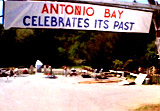 100th Anniversary of Antonio Bay  Father Robert Malone (Hal Holbrook)  "6 MUST DIE" Plank Exploding into Flames  Number 3 Scratched on Floor  Death of Weatherman Dan O'Bannon  Chase Sequence  Ghostly Sea Zombies in Church   Massive Gold Cross and the Ghost of Blake, Confronting Father Malone  Stevie's (Adrienne Barbeau) Radio Broadcast  Father Malone Decapitated |
||||||||||||

|
The Forgotten (2004)
Director Joseph Ruben's mystery/sci-fi horror thriller was taglined:
A more telling tagline provided a clue to the plot:
The film began with the main character - a grieving Brooklyn mother:
She had saved a scrapbook and other mementos until she noticed signs that her evidence of Sam's existence was slowly evaporating and disappearing (there were erased videotapes, and missing and doctored pictures). Then, she was being told by her husband and others, including psychiatrist Dr. Jack Munce (Gary Sinise), that Sam hadn't really existed and she should forget Sam entirely. She was diagnosed as suffering from paramnesia - her doctor told her that she never had a son (following a miscarriage), that she had "memory slips," and that she had "invented memories" of Sam. The fact that the evidence was disappearing, according to her husband Jim (Anthony Edwards), meant that she was coming back to reality, but she began to fear that the loss of her son was part of an unusual conspiracy.
She finally convinced her neighbor, alcoholic ex-hockey player Ash Correll (Dominic West), after ripping wallpaper from one of his bedroom walls to uncover a daughter's drawings, that he also had 'forgotten' a missing daughter named Lauren (Kathryn Faughnan) - one of Sam's playmates, who was on the same plane flight with him to camp. Although he turned her into police at first, Ash then 'remembered' - and they both went on a hunt to find the truth - and their children:
After the first half of the film - an emotional and despairing look at maternal suffering, grief, deception and sanity, the film became a sci-fi alien abduction flick (similar to The X-Files). Pursued by agents of NSA and by the police, and by a "Friendly Man" (Linus Roache) (who was invulnerable to harm and had frightening powers), they theorized that their children had been abducted. They kept asking about why they were both told: "There are no children. Forget the children." And why were the children taken? And how could they get them back? They coerced captured NSA agent Al Petalis (Lee Tergesen) to admit some sort of 'cooperation' - for survival's sake and for all of mankind - with some unknown beings. The two were shockingly told: "The goddamn truth won't fit in your brain. It won't fit in anybody's brain." For some reason, it was clear that Telly had somehow overcome forces compelling her to forget, during some sort of 'alien' experiment about parental memory: "All I know is that you were supposed to forget like everybody else did." When he whispered in her ear: "They're listening" - he was whisked away and the entire house around them was demolished. The illogical, preposterous and contrived conclusion brought NY Detective Anne Pope (Alfre Woodard) together with Telly at the abandoned Long Island home of the bankrupt President of the ill-fated QuestAir airplane, Robert Shineer (also Linus Roache), where Anne was also abruptly whipped into the sky (by an inexplicable force) after Anne had promised Telly that she would help her to find the children: "I believe you about everything. I've seen it. It's not human. Jesus Christ....We will find your son." And in the next scene, Ash was also whisked away after a crashing fall through a window. Just before a final showdown with the "Friendly Man," Telly learned from her knowledgeable therapist Munce, who knew about everything all along, that the 'aliens' were conducting invasive memory experiments:
Because Telly had never doubted, through the powerful force of her own will and faith in her son's existence, her son Sam was never forgotten, and remained a strong memory. She kept insisting on getting her son back -- when she asked the 'alien': "He's just a little boy. What could you possibly learn from him?", she was told that she was the experiment:
The 'alien' again demanded that Telly forget her son so that his experiment wouldn't fail, explaining: "I'm accountable. I can't let that happen. And time is running out." He yelled at her: "You need to forget" and shattered glass throughout the building with his powerful voice -- but she refused to cooperate, even when he choked her and observed: "You're different from the others. Why?" He compelled her to forget her son Sam: "It's better this way. You won't be haunted by his memory. You could have a life again." He forced her to revisit her delivery day in the hospital - "I need that first memory. Give me that first memory!" - and wiped her memory clean of the birth and her first view of Sam. Although that particular memory was wiped clean, he didn't count on her remembering her earlier pregnancy as she touched her belly ("I had life inside of me. I had life. I have a child. I have a son. I have a son. His name is Sam, you son-of-a-bitch!") -- and as the 'alien' spoke: "I need more time" - he was abruptly yanked through the roof. Presumably, the alien experiment had failed. In the film's happy conclusion, Telly was reunited with her son Sam on a playground, and Lauren was also there, with Ash watching her from a nearby swing. Telly and Ash became reacquainted (Ash: "I think we met before"). Everything was restored to normal by the 'alien' life-form (was a time clock wound backwards, or was there another memory trick being played?) - and only Telly could recollect what had happened (she had fallen in love with Ash, but was still married to her husband, who at one point had entirely forgotten her!). |
  Evidence: A Doctored Picture 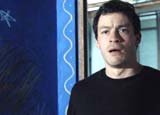 Telly's Neighbor Ash Correll (Dominic West)  Another 'Forgotten' or Missing Daughter, Lauren Correll   "Friendly Man" (Linus Roache)  Telly Revisiting Delivery Day of Child Sam  Telly Remembering Her Pregnancy   Parents Reunited with "Forgotten" Children - The Alien Experiment Failed |
||||||||||||

|
1408 (2007) (Theatrical Version)
This quirky mystery-horror thriller from Swedish director Mikael Håfstrom was based upon a Stephen King novella (published in the compilation "Everything's Eventual: 14 Dark Tales"). There were various alternate endings to the film - described below was the theatrical version. Its main character was:
Enslin's latest ghost survival guide was titled "10 Haunted Hotels." Other titles he wrote were:
He rated locales on a "Shiver Scale" of 1-10 skulls (with ten the highest). In every new site which he personally stayed in, he brought along an EMF meter, full-range spectrometer, and an infrared camera to scientifically measure findings. He wore a cap reading: "Paranoia is Total Awareness." One crucial fact was that he did not believe in paranormal evil and events, and was a skeptical debunker of the idea of ghosts (what he termed "spook-house bulls--t"). He was an athiest, who didn't believe that there was a God to protect humans from "ghoulies and ghosties." At a book-signing talk, one admirer named Anna (Alexandra Silber) presented him with his first, much older, inspirational book to sign (it was autobiographical - he was the "bastard" father!). Its title was a clue to the remainder of the film: "The Long Road Home." He had changed after suffering an extreme emotional tragedy in his family, yet to be revealed (the terminal illness/death of his daughter Katie (Jasmine Jessica Anthony)), and he was estranged from his wife Lily (Mary McCormack) who lived in New York. He had abandoned his more promising literary career for the less-personal market of a series of top 10 horror books, while surfing and living in Hermosa Beach, California. Later, he was described as "full of cynicism...talented intelligent man who doesn't believe in anything or anyone but himself." While ocean surfing, he experienced a major concussion when hit in the head by his board -- but everything that happened afterwards could not be interpreted as his dream!
He received an unsigned picture postcard (sent in late May 2007 - the present-day framework of the film) from the Dolphin Hotel (in New York City's Manhattan) with a brief message: "Don't Enter 1408."
The challenge took Mike to the East Coast (and New York City - where all his real-life 'ghosts' did indeed reside). He insisted on staying in Room 1408 of the Dolphin (located at 2254 Lexington Ave - the numbers added up to 13), although the hotel's manager Mr. Gerald Olin (Samuel L. Jackson) desperately tried to dissuade him with tales of both haunted and natural deaths in Room 1408 (the numbers added up to 13, and the room was on the '13th floor'). Olin offered him a drink of cognac grande champagne, 1939's "Les Cinquante Sept Décès" (French for "The 57 Deaths"), forcing Enslin to later ask himself if he had been drugged.
Olin's final threat was - "it's an evil f--king room!" Other historical details in the 95 year history of the hotel:
The film played upon primal fears (isolation, alienation, unease and loneliness in an unfamiliar surrounding, such as a hotel room), and the major problems customers always find in hotel rooms ("Hotel rooms are a naturally creepy place"), although exaggerated (Enslin called the room a 'sarcophagal chamber'):
Most importantly, in his subconscious, he was haunted by the voice of his deceased daughter Katie playing hide-and-seek. Enslin spoke into his voice-recorder about running away from reality: "You're running to places that aren't real...You're losing the plot. You're losing the whole goddamn structure" - the crux of his life's difficulties! He recalled that his daughter had died of cancer, a time when he had also lost faith in God ("What kind of God would do this to a little girl?"). He had shattered his family's hopes about contemplating and promising the prospects of life after death. He had argued with Lily about their treatment of dying Katie:
And he had walked out on Lily a year earlier - not explaining whether it was a divorce or separation. During his intense hallucinations in the room, he was literally facing his own physical death (he metaphorically was the "man overboard" in the animated painting), drowning in the room (and California surf as he did earlier with his surfboard accident!). Now, it appeared that he was "ready to deal with this stuff," as Lily suggested. He rescued himself by communicating with Lily, bringing him peace, comfort, and calm. (In his delusion, she visited him in LA as he was recovering from his surfing accident.). He believed that he had escaped, but then he found himself back in Room 1408, looping back into the "horrible dream," although momentarily he thought he had been rescued and renewed. He was back in the imprisoning room - doomed. The "ghost" of Katie came to him for a loving embrace, but then died and crumbled in his arms. He received one final recorded hotel phone call with a choice: "You can choose to relive this hour over and over, or you can take advantage of our express check-out system." He imagined hanging himself, but then changed his mind and chose life. Finally admitting that he had lived a selfish life, he escaped by taking the literal advice of a hand-scratched message on a brick wall: "BURN ME ALIVE!" He set the room afire with a molotov cocktail, setting off alarms and summoning firetrucks to the rescue. On the street below, Lily instructed firemen to find him on the 14th floor. Mr. Olin was heard congratulating Enslin for living: "Well done, Mr. Enslin." He recuperated in a NY hospital, and was moving back (or returning 'home') to Los Angeles to be with Lily. In voice-over, he ended the film - as he wrote the postscript for his book (he gave the Dolphin 10 skulls):
The sole possession he kept from the fire was his voice-recorder. In the midst of the move to LA, he found his tape recorder in a box. He played back one of the audio recordings he had made, as Lily listened in disbelief - it was of Katie speaking to him when he was hugging her ("I'm not gonna let you go") in the hotel room, proving that the events in 1408 actually happened (and that Katie's 'ghost' was real). |
  Writer Mike Enslin (John Cusack)  Living in Hermosa Beach - Concussion While Surfing  Unsigned Picture Postcard from NYC's Dolphin Hotel 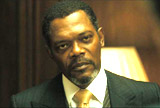 Dolphin Hotel's manager Mr. Gerald Olin (Samuel L. Jackson)  Room 1408 on 13th Floor  Count-down Alarm Clock 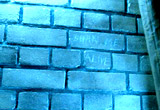 Brick Wall   Wife Lily (Mary McCormack) With Daughter Katie  Airplane Banner   "Ghost" of Katie Dying in His Arms  Setting Hotel Room On Fire  Hospitalized, With Lily Visiting Him  The Ordeal Was Real - Playing Back the Tape Recording |
||||||||||||

|
Fracture (2007)
Director Gregory Hoblit's intense legal thriller and crime mystery involved an attempted murder and the subsequent trial. Its tagline stated:
The two main protagonists who were to become engaged in a battle of wits in the courtroom attempted-murder trial were:
In the film's opening, Crawford found evidence (on November 10th) that his young attractive 'trophy' wife Jennifer (or "Jen") (Embeth Davidtz) was engaged in an affair (later revealed as twice-per-week) in the same hotel in Santa Monica (in LA's Southern California). She was swimming in the Fairmont Miramar Hotel & Bungalows pool area with virile Lt. Robert Nunally (Billy Burke), LAPD's head hostage negotiator, where both signed in as Mr. and Mrs. Smith.
After his cheating and unhappy wife drove home, Crawford confronted her ("Knowledge is pain"), told her he loved her, then seriously wounded her by shooting her in the head at close range as she turned toward him. He wiped the used shell casing with a handkerchief. He also fired three shots at nearby windows to scare off the gardener, and then scrubbed his forearms and face with hot water.
The investigating cop sent to the scene was Lt. Nunally, who was soon shocked to find the victim was his secret lover. Crawford allowed only Nunally into the house - and then persuaded that they both put down their pistols. Crawford then confessed on the scene to shooting his wife ("It's just like I suddenly snapped, and I got the gun and I shot her in the head. I know it was wrong. Are you listening to me, Rob?"), and hinted that he knew Nunally had 'screwed' his wife. Nunally saw his own lover - bloody, comatose and barely alive on the floor in an adjoining room, and he tried to revive her. When Crawford appeared behind him in the room brandishing a gun, Nunally grabbed for the weapon, then tackled and assaulted Crawford before he was arrested by SWAT team members, and charged with the crime. Crawford's weapon was taken as evidence and bagged.
During an immediate courtroom trial in which Beachum thought he had a 'foolproof' open-and-shut attempted murder case (with a weapon and a signed confession), Crawford represented himself, and challenged Beachum before the trial: "You look closely enough, you'll find everything has a weak spot where it can break, sooner or later" -
Jennifer was the sole witness who could testify against her husband Crawford (who had shot her), but hopes of her testifying against him vanished when Crawford threatened to use his 'health care proxy,' and he ordered her removed or unplugged from life support. Beachum worried: "This man's gonna kill his wife." Beachum secured a court order to stop the disconnection, and delivered it to the medical center just as Jennifer was flat-lining - he was unsuccessful in halting her death. Beachum was tipped off to the possibility of two identical guns (used by Nunally and Crawford) when he accidentally picked up the cellphone of his assistant. After Jennifer's death, the incriminating bullet in her head was examined and matched up with the weapon (removing it while she was alive was too risky). Beachum told Crawford in his home during their final confrontation:
Egotistical Crawford was confident about revealing to Beachum his crime of attempted murder - and he confessed to his guilt:
Crawford then smirked and believed that he was protected by the "double jeopardy clause":
Beachum countered that now that Crawford had actually killed his wife, he could be charged with murder:
Beachum walked outside, where police had been listening in, and Crawford was subsequently charged with murder. As the film concluded, once again, Beachum was back in court trying Crawford for the new crime. |
 "Ted" Crawford (Anthony Hopkins)  The Murder of Crawford's Wife Jennifer     The Gun - Switching the Evidence   The Cat and Mouse Game Between Crawford and "Willy" Beachum (Ryan Gosling)  Nunally's Suicide    A New Trial for a New Crime |
||||||||||||

|
Frailty (2001)
This haunting psychological horror-thriller by Bill Paxton (his directorial debut film) had the tagline:
A person claiming to be Fenton Meiks (Matthew McConaughey as adult) spontaneously confessed to Dallas FBI Agent Wesley Doyle (Powers Boothe). He claimed that his brother Adam (Levi Kreis as adult) (whose body was in an ambulance after he committed suicide) was the likely, self-proclaimed "God's Hand" serial killer. Adam was to be buried in his hometown of Thurman, Texas, in a public rose garden. It was later revealed, through flashbacks, that both Adam (Jeremy Sumpter as young Adam) and Fenton (Matthew O'Leary as young Fenton) had been brought up in a strictly-religious household with a delusional, possibly schizophrenic, redneck widowed father (Bill Paxton). Their crazed father had religious visions of "God's will" that led him to enact divine retribution as a mission - to kill 'demons' that he saw in various individuals ("They may look like people on the outside, but inside...", and "We don't kill people, we destroy demons"). Individuals who were identified as demons were abducted, taken to the Meiks home, axed to death, and then buried in the rose garden. Both sons were present for the 'divine' slayings - and were required by their father to be his murderous accomplices. As young boys, Fenton had urged his brother Adam to make a promise, and bury him in the rose garden if he was ever to be 'destroyed':
In the present day, "Fenton" (actually Adam) took agent Doyle to the public rose garden near his old home, where he claimed that his brother Fenton was buried. Doyle was confused. "Fenton" then admitted that it all made sense "if that man standing in front of you is Adam Meiks." In the upending, contrived twist ending, there was now an abrupt change in the identity of the film's narrator - it was Adam, not Fenton, who had been narrating and was the surviving brother. Adam had 'destroyed' his brother Fenton, and then posed as Fenton to cover up. Adam then eerily confessed to Doyle that only 'demons' were buried in the rose garden - and he had regarded Fenton as a demon:
As it turned out in the film's conclusion, young Adam was the only one who truly shared his father's delusions and killer impulses, and became the new "God's Hand" serial killer. Young Adam had acquired the duty of killing demons, and accepted the task of killing his brother Fenton (Fenton couldn't accept the mantle of being a killer, and had rebelled against their father with an axe). Adam came up behind his brother Fenton and clobbered him on the head (Fenton had not committed suicide). Then, after Doyle accused Adam of being a murderer, Adam counter-accused Doyle of also being a 'demon' - a mother-murderer - who deserved to justifiably be killed - upon touching Doyle, he had a vision of her murder:
He threw Doyle's body in an open grave, took an axe, and mortally struck Doyle. Adam predicted (rightly) that everyone would be looking for Fenton - not himself. Since everyone thought that the confessor in Doyle's office was Fenton, Adam (posing as Fenton) was able to get away with the murder (and the fuzzy security camera pictures didn't help to identify him when he first came to the Dallas FBI office). When FBI agents burst into Fenton's home, they found an incriminating list of victims - including the latest crossed off name ("Wesley Doyle"). Doyle's bloody wallet was found in the basement. All of the clues in Doyle's disappearance and death led to "Fenton." In the final scene, FBI Agent Griffin Hull (Derk Cheetwood) went to Adam's town in Enid County to tell him about his brother Fenton's guilt and involvement. He requested that Adam provide any further information or leads. Adam was the town sheriff and his wife Becky (Missy Crider) was pregnant:
|
 The Meiks Family: Two Sons and Murderous Father  Adam Meiks (Jeremy Sumpter)  Fenton Meiks (Matthew O'Leary)  Fenton Meiks (Levi Kreis as Adult)  Adam Meiks (Matthew McConaughey as Adult) (posing as brother "Fenton") After Murdering Him  The Rose Garden Scene: Adam With Agent Doyle  Vision: Doyle's Mother During Her Stabbing-Murder  Doyle on "Fenton's" Hit-List  Sheriff Adam Meiks  Pregnant Wife Becky With Adam |
||||||||||||
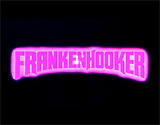
|
Frankenhooker (1990)
Horror filmmaker Frank Henenlotter's popular midnight movie mixed black comedy, horror, and sleazy sexploitation, in order to update Bride of Frankenstein (1935) and serve as a follow-up film to the Re-Animator series. Its humorous tagline was:
The main character in this R-rated (available as "unrated" also) film was electrician/mad scientist Jeffrey Franken (James Lorinz) - a neurotic medical school dropout (now a blue-collar engineer). He lived with his mother (Louise Lasser) and was engaged to Elizabeth Shelley (ex-Penthouse Pet Patty Mullen). He became insane when Elizabeth was chewed up by his remote-controlled lawn-mower in a freak and tragic accident. After preserving her head in a freezer (in a gooey purple liquid), his goal was to resurrect her body to its former self by stitching the head to other female body parts. He murdered a group of prostitutes in a hotel by serving them "super-crack" - causing them to detonate (in the film's most memorable sequence), and then took their severed limbs and parts to his laboratory to sew together and re-animate with electricity. His resultant "Bride of Frankenstein" was a sexually-ravenous nymphomaniac and undead (but deadly) "Frankenhooker" who went on the prowl for johns ("Wanna date?"). Every time she kissed a male client, he would explode. In the most bizarre, sickly humorous twist ending - a great surprise - after Jeffrey was decapitated by a pimp named Zorro (Joseph Gonzalez), he had his head grafted onto the body of a large breasted hooker's body in order to be rejuvenated. As he awoke on an uprighted table, he lamented to Elizabeth:
The film concluded with Jeffrey moaning in anguish. |
 Elizabeth (Patty Mullen) - Frankenhooker 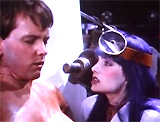  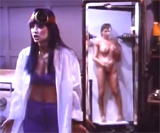  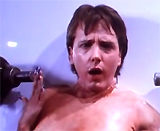 Jeffrey With Female Body |
||||||||||||

|
Frantic (1988)
Director Roman Polanski's suspenseful, Hitchcock-like mystery-thriller began with American Dr. Richard Walker (Harrison Ford) and his wife Sondra (Betty Buckley) arriving in Paris for a medical conference where he was to deliver a paper. They had honeymooned there 20 years earlier. At their hotel while she was unpacking, they both discovered that they couldn't unlock her suitcase. While Dr. Walker was taking a shower, she mysteriously disappeared (she was forcibly taken and forced into a car). Jet-lagged and fatigued and unable to speak French, he followed various leads to search for her, with little assistance from hotel staff, Parisian police and the bureaucratic US Embassy, and was unable to locate his missing (presumably kidnapped) wife. Apparently, Sondra had mistakenly picked up the wrong suitcase at the airport. [She took a similar-looking suitcase that contained a smuggled and concealed atomic bomb detonator.] After prying open the mistakenly-taken suitcase, Walker found - among other things - a small Lady Liberty statue ceramic replica. He didn't know that hidden inside the statue was an atom bomb device, a krytron (a small electronic detonator for a nuclear bomb) - the film's MacGuffin. While following clues, he came across a streetwise young woman - a mischievous, sexy courier (career smuggler) named Michelle (Emmanuelle Seigner). She admitted to picking up the wrong suitcase at the airport - Sondra's. Then, she agreed to help him, in exchange for the money she was owed for trafficking in narcotics, to search for their suitcase. As she helped him during a frantic and tense search, he stumbled across an underworld of European drug smuggling involved in terrorist arms sales. In the film's conclusion set by the River Seine, the two confronted two Arab terrorists on a boat, who released Walker's wife unharmed ("My wife first!"), in exchange for the trigger device. With the device in her hand, Michelle approached the terrorists and demanded to be paid 10,000 francs ("Give me my money or I'll throw your f--king thing in the river!...I still wasn't paid"). During intense crossfire in a gunfight with police from a nearby bridge, the terrorist dealers were killed, and Michelle was lethally shot. Before dying, Michelle slipped the trigger device into Walker's right coat pocket. An angry and disgusted Walker threw the krytron device into the fast-moving river after asking the police agents:
|
 The Wrong Suitcase  The Lady Liberty Statue (With a Device Inside)  Michelle (Emmanuelle Seigner)   Michelle's Death By the Seine River |
||||||||||||
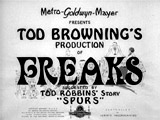
|
Tod Browning directed the unusual, gothic film with real-life side-show "freaks" - one of his best works. This cult film redefined the concepts of beauty, love, and abnormality, but was so disturbingly ahead of its time that audiences stayed away in huge numbers, and it was even banned for 30 years in England. Seeking revenge on evil, gold-digging aerialist Cleopatra (Olga Baclanova) for plotting to kill the wealthy midget Hans (Harry Earles) by poisoning him, fellow freaks attacked her lover - strongman Hercules (Henry Victor) with knives and killed him during a fierce rainstorm (the murder was off-screen). The freaks also put their curse on Cleopatra by turning her into a half-chicken woman (off-screen). She was then displayed in the carnival as a side-show 'freak.' |
 The Freaks' Revenge  Cleopatra - Now a Half-Chicken Woman |
||||||||||||
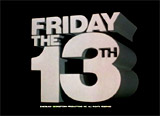
|
In this classic slasher film set in either 1979 or 1980 (on a full-moon Friday the 13th, the birthday of Jason!), the serial killer was not son Jason Voorhees (Ari Lehman) - emphasized in the opening of the film Scream (1996), but his camp kitchen-worker mother Mrs. Voorhees (Betsy Palmer). She was taking revenge for her 11 year-old son's accidental death from drowning in the lake over two decades earlier in 1957 (when camp counselors at Camp Crystal Lake were distracted while having sex and avoided their supervisory duties). In the shock ending, after sole surviving camp counselor Alice Hardy (Adrienne King) decapitated the insane woman with her own machete after a violent struggle by the lake, she took a canoe ride out to the middle of the tranquil lake, where the long-lost, re-animated, half-decomposed corpse of Jason suddenly burst out of the lake and attacked her the next dawn. She was grabbed by the neck and pulled underwater, but it all appeared to be an hallucinatory nightmare (or was it real?) as Alice awakened screaming "No!" in a hospital bed. She was told by a police officer that she was the sole survivor:
The film ended after she pondered to herself:
Jason would not become the killer until the next installment of the franchise, Friday the 13th, Part 2 (1981). The sequel's prologue recapped the ending of the 1980 film - two months later, Alice was reliving the horror of that night, when she decapitated Mrs. Voorhees with a machete, was attacked in a canoe on the lake by the rotting decomposed corpse of Jason, awoke screaming in a hospital bed, and was told by a police officer that she alone had been pulled from the lake - culminating with her final words in the original film: "Then he's still there." She was struggling to put her life back together, as she told her mother on the phone. |
  Mrs. Voorhees (Betsy Palmer) Decapitated   Alice's Hospital Nightmare of Jason's Appearance |
||||||||||||
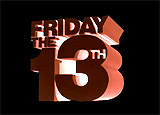 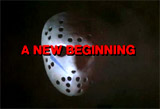
|
Friday the 13th, Part V: A New Beginning (1985)
In this fifth installment about the hockey-masked killer Jason Voorhees, the tagline was:
Although the film's plot led you to believe that Jason was the returning maniacal, homicidal killer, most of the film's murders (there were 22 total deaths) were committed by a 'Jason' copy-cat - paramedic Roy Burns (Dick Wieand), who sliced, stabbed and spiked seventeen (17) individuals throughout the film. His killing rampage, mostly of peripheral characters, was triggered by the sight of the hacked body of a troubled youth at Pinehurst halfway house when he came to take away the corpse of obese chocolate bar-eating orphan Joey Burns (Dominick Brascia), who had been chopped up with an axe by angry, short-haired resident Vic (Mark Venturini). He was visibly upset by the bloody and maimed remains of the victim lying in hacked-up pieces on the ground. The killer was revealed in the conclusion when 'Jason' was knocked out of an upper barn window onto a bed of iron-spiked farm equipment (a tractor harrow) below where his body was impaled. The hockey-mask was dislodged from his face and the rain washed away his 'Jason' makeup, showing that he was not 'Jason,' but disgruntled ambulance paramedic Roy Burns. Sheriff Tucker (Marco St. John) explained that Roy was seeking retribution for the death of his long-lost patient son Joey and had used the persona of 'Jason' as a cover-up:
Feeling guilty for abandoning his infant son, the disgruntled psychopath sought vengeance on those who had tormented Joey - and many others. When Roy arrived on the traumatic scene and saw his son "all hacked to pieces," he went insanely crazy. His rationale was explained:
As the film concluded (in preparation for the next sequel), it concentrated on the character of hallucinatory, mentally-disturbed and Jason-crazed Tommy Jarvis (John Shepherd), one of the halfway house residents. 10 years earlier (in Friday the 13th, The Final Chapter (1984)), he had killed the goalie hockey-masked killer Jason Voorhees. Tommy donned the hockey mask and stabbed to death Pinehurst's Assistant Director Pam Roberts (Melanie Kinnaman) who had come to his room. Although it was a nightmare, it wasn't just a dream the second time around - and he prepared to attack her again (he was hiding behind his room's door) with his upraised machete. (Was he the next Jason?) The film ended with a zoom to his eyeball under the mask, and a fade to black before the credits. |
 Murder Scene - Triggering the Rampage  Paramedic Roy Burns (Dick Wieand)  Copy-Cat Jason  The Killer Revealed - Roy 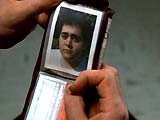 Axed Boy Was Roy's Son  Stabbing - A Nightmare Dream!  Hallucinatory, Jason-Crazed Tommy (John Shepherd)   Director Pam Roberts About to Be Macheted by Tommy/Jason? Not a Dream |
||||||||||||